This Post May Contain Affiliate Links. Please Read Our Disclosure Policy.
This flavorful bone-in ribeye is cooked medium-rare and perfectly tender using the easy but masterful reverse sear method. Served with a delicious, easy garlic-herb butter, this recipe is better than the restaurant! With a guide on cooking to other steak temperatures, as well.
This recipe is sponsored by Sprouts Farmers Market, but all thoughts and opinions are my own.

What Makes This Recipe So Good
- The reverse-sear method is the best way to cook ribeyes. Hands-down, period, no questions asked, end of story. This low-and-slow method gets you perfect, evenly-cooked, juicy, tender steak with a slightly crisp edge every single time.
- Are bone-in steaks better than boneless steaks? “Better” is a matter of preference, but there’s no use pretending bone-in steaks aren’t amazing. The bone adds so much flavor and moisture to the meat. They take a little longer to cook than boneless steaks, but trust me, it’s completely worth it.
- It’s super easy to put together, but looks elegant and tastes incredible. That makes it perfect for special occasions like anniversaries, date-nights, celebrations, or Valentine’s Day. Even the delicious garlic herb butter will blow you away!
- Everything you need for this recipe is available at Sprouts Farmers Market! One-stop shopping is a big deal in my book, and when I’m planning out meals for the week, I always prioritize recipes that don’t have me running all over town picking up one ingredient here and one ingredient there.
Key Ingredients
Bone-In Ribeyes – The reverse-sear method doesn’t work as well on any ribeye thinner than 1″, so keep that in mind when you’re choosing your steaks. I get my bone-in ribeyes from Sprouts Farmers Market. They always have delicious, high-quality cuts of meat available in their Butcher Shop, and their bone-in ribeyes are no exception. They’re sourced from heritage-breed cattle that’s raised in the U.S., and there’s no added hormones, ever.

How Do I Cook Steak to the Perfect Temperature?
It’s all in the timing! Instead of setting a timer or guessing based on how they look, you need to read the temperature of the meat. The key is to remove your bone-in ribeyes from the oven before they reach your ideal temperature, because they’ll continue cooking while they rest, and then they’ll cook a little more in the cast-iron skillet.
- For rare steaks, your final temperature should be somewhere between 120° and 125° Fahrenheit. Remove the steaks from the oven when their internal temperature reaches 110°F.
- Medium rare steaks, like the ones in this recipe, should end up somewhere between 130°-135° Fahrenheit. Remove the steaks from the oven when their internal temperature reaches 120°F.
- For medium steaks, you want a final temperature of 140° to 145° Fahrenheit. Remove the steaks from the oven when their internal temperature reaches 130°F.
- Medium well steaks are on the high end with a target temperature between 150° and 155° Fahrenheit. Remove the steaks from the oven when their internal temperature reaches 140°F.
- Well done steaks… First, can I beg you to cook them just a little less? Please? Well done steaks can be tough and dry, and I just can’t let you do that to yourself! If you’re determined, though, you’ll want to aim for a final temperature between 160° and 175° Fahrenheit. Remove the steaks from the oven when their internal temperature reaches 155°F.
Chef’s Tips
- Always use tongs to handle the bone-in ribeyes when you’re cooking them. Tongs won’t pierce the meat, which means none of the juices will escape.
- There’s only a few degrees difference between each meat temperature, so I really, really encourage you to use an internal meat thermometer with a probe here. Leave-in style probe thermometers are great because you basically get a live-feed of your ribeyes’ internal temperature throughout the cooking process. Not all meat thermometers are leave-in style, though, so double check the one you’re using before you pop it in the oven.
- Since they rest right after the oven, the ribeyes will be ready to eat as soon as they’re done in the skillet. Keep that in mind when you’re preparing your sides!
- The longer you let the bone-in ribeye stand in their salt & pepper dry rub, the more flavorful they’ll be. 30 minutes is the bare minimum – ideally you should let them stand at least 2 hours. Be sure to factor that long standing time in when you’re planning this recipe!
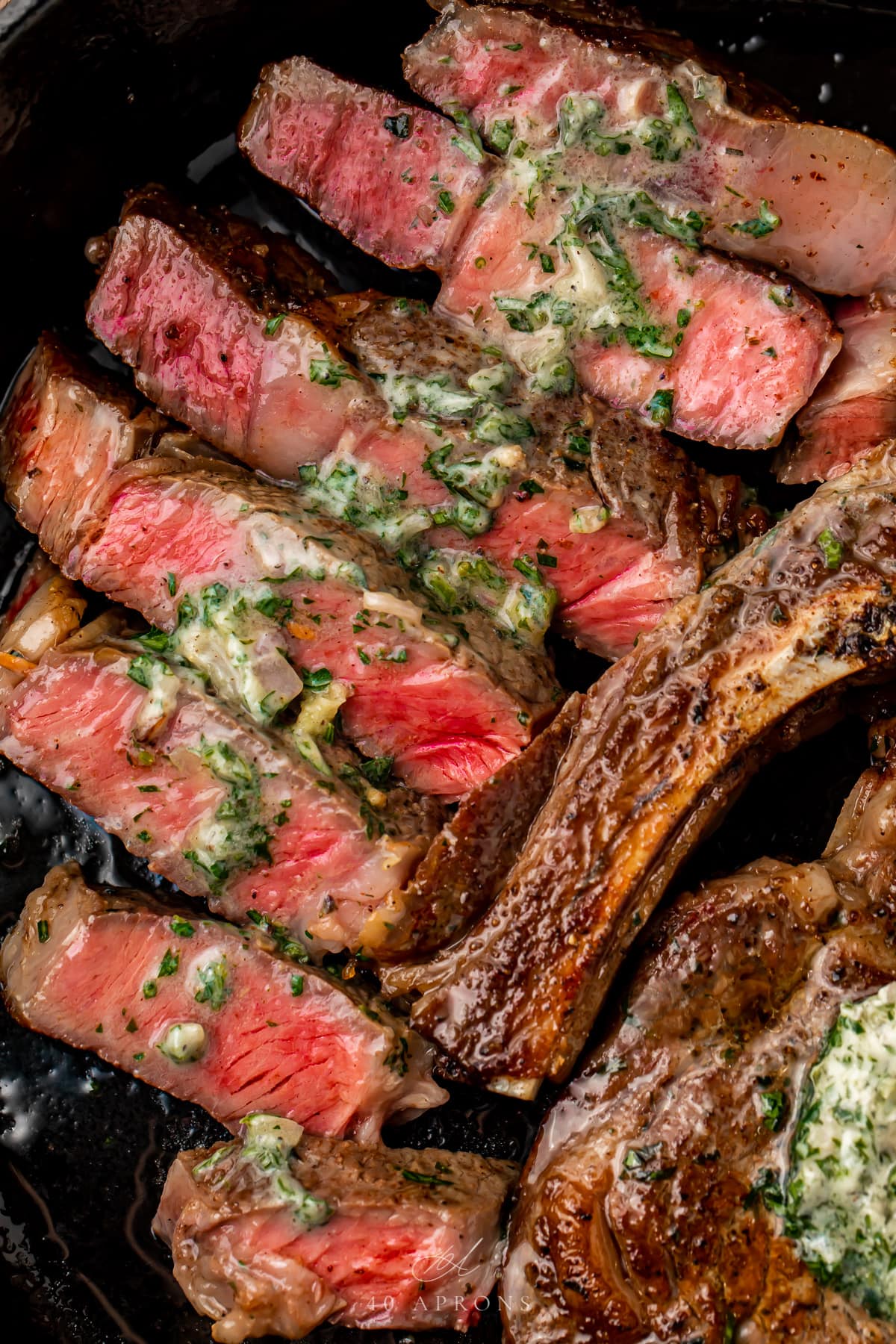
More Date-Night Recipes You’ll Love
- White Clam Sauce
- The Best Avocado Chocolate Mousse (Vegan, Dairy Free)
- Cookie Butter Creme Brulee
- The Best EVER Risotto Recipe
- Marry Me Chicken
- Bacon-Wrapped Scallops with Herb-Butter Sauce
- Bearnaise Sauce
- Reverse Sear Prime Rib
- Salmon Wellington
- The Best Lobster Bisque (Ruth’s Chris Copycat Recipe)
- Chicken Carbonara
- Vegan Creme Brulee
- Sous Vide Lobster Tails
- Keto Truffles
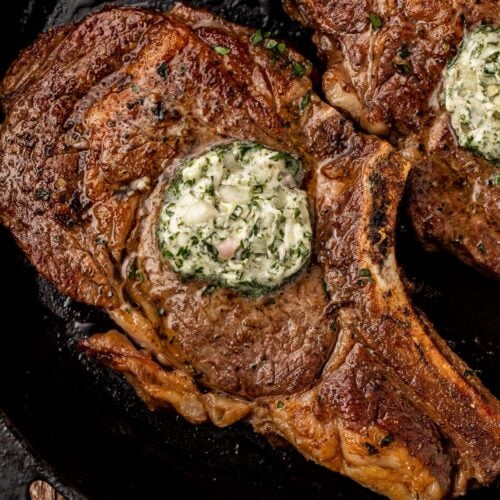
Bone-In Ribeye with Garlic-Herb Butter
Equipment
- wire baking rack
- baking sheet
- Food processor
- Plastic wrap
- Meat thermometer
- Skillet
- Tongs
Ingredients
For the Steaks
- 2 bone-in ribeyes about 1" to 1 ½" thick
- salt to taste
- freshly cracked black pepper to taste
For the Garlic-Herb Butter
- ½ cup unsalted butter softened
- 2 tablespoons fresh parsley roughly chopped
- 2 tablespoons fresh herbs of choice chopped, see Notes
- 1-1½ teaspoons garlic roughly chopped
- 2 tablespoons shallot roughly chopped
- 1 tablespoons fresh lemon juice
- ½ teaspoon salt
- ½ teaspoon freshly cracked black pepper to taste
Instructions
- Liberally season steaks with salt and pepper on both sides. Place on wire rack over baking sheet and let stand at room temperature at least 30 minutes, but preferably a couple of hours. If letting stand more than one hour, keep in refrigerator, then let stand at room temperature 30 minutes before cooking.
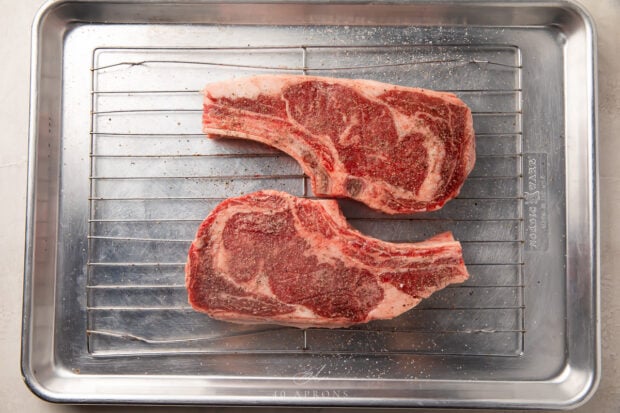
- While ribeyes stand, make garlic-herb compound butter. Place all ingredients in food processor and process until smooth. Spoon onto plastic wrap and roll into a log shape. Chill until firm.
- Preheat oven to 250° Fahrenheit. Place baking sheet with steaks in oven and insert an internal meat thermometer with probe.
- For medium-rare steaks, cook until internal temperature reaches 120° Fahrenheit, approximately 35-40 minutes. Larger or thicker steaks will take longer to reach temperature, so I highly recommend using an internal meat thermometer with probe here. See Notes for alternative temperatures.
- Remove from oven when internal temperature reaches 120° Fahrenheit. Preheat a cast-iron skillet over high heat for 5 minutes while steaks rest.
- Pat steaks dry and place in hot skillet. Cook 45 seconds, then flip. Place a pat of garlic-herb compound butter (approximately 1 tablespoon per steak) on top of ribeye. Cook another 45 seconds, then flip a couple of times until steaks are a rich brown color, approximately 20-40 seconds total. Press the sides of the ribeyes up against the sides of the cast-iron skillet briefly until no longer red or pink.
- Remove from skillet and serve with more garlic-herb compound butter.
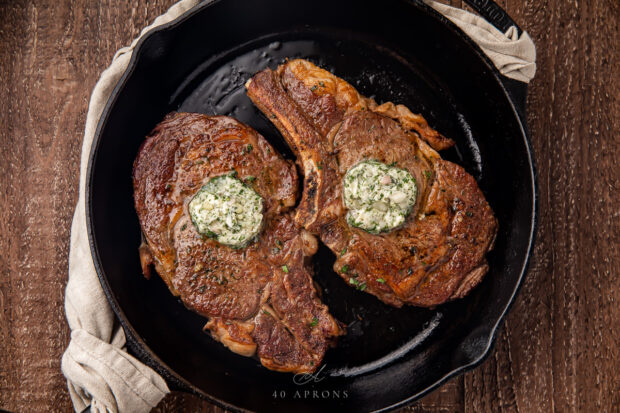
- For the garlic-herb butter, any fresh herbs will do. I generally use tarragon, oregano, or thyme, but use your favorite(s) here!
- Rare | Target temperature: 120°-125°F. Remove from oven when internal temperature reaches 110°F.
- Medium Rare | Target temperature: 130°-135°F. Remove from oven when internal temperature reaches 120°F.
- Medium | Target temperature: 140°-145°F. Remove from oven when internal temperature reaches 130°F.
- Medium Well | Target temperature: 150°-155°F. Remove from oven when internal temperature reaches 140°F.
- Well Done | Target temperature: 160°-175°F. Remove from oven when internal temperature reaches 155°F.
Approximate Information for One Serving
Nutrition Disclaimers
Number of total servings shown is approximate. Actual number of servings will depend on your preferred portion sizes.
Nutritional values shown are general guidelines and reflect information for 1 serving using the ingredients listed, not including any optional ingredients. Actual macros may vary slightly depending on specific brands and types of ingredients used.
To determine the weight of one serving, prepare the recipe as instructed. Weigh the finished recipe, then divide the weight of the finished recipe (not including the weight of the container the food is in) by the desired number of servings. Result will be the weight of one serving.
Did You Make This Recipe?
Tag @40aprons on Instagram and be sure to leave a review on the blog post!
Never Miss A Meal!
New Recipes Straight To Your Inbox
A curated selection of our most recent recipes, delivered straight to your inbox once a week.
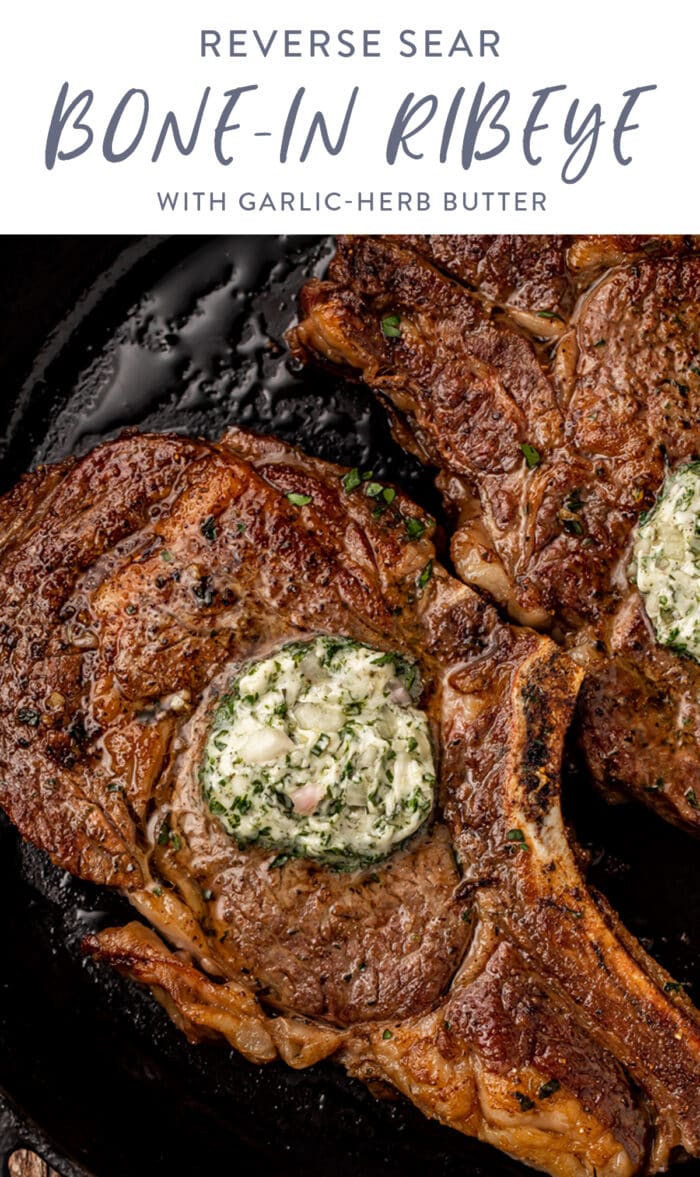
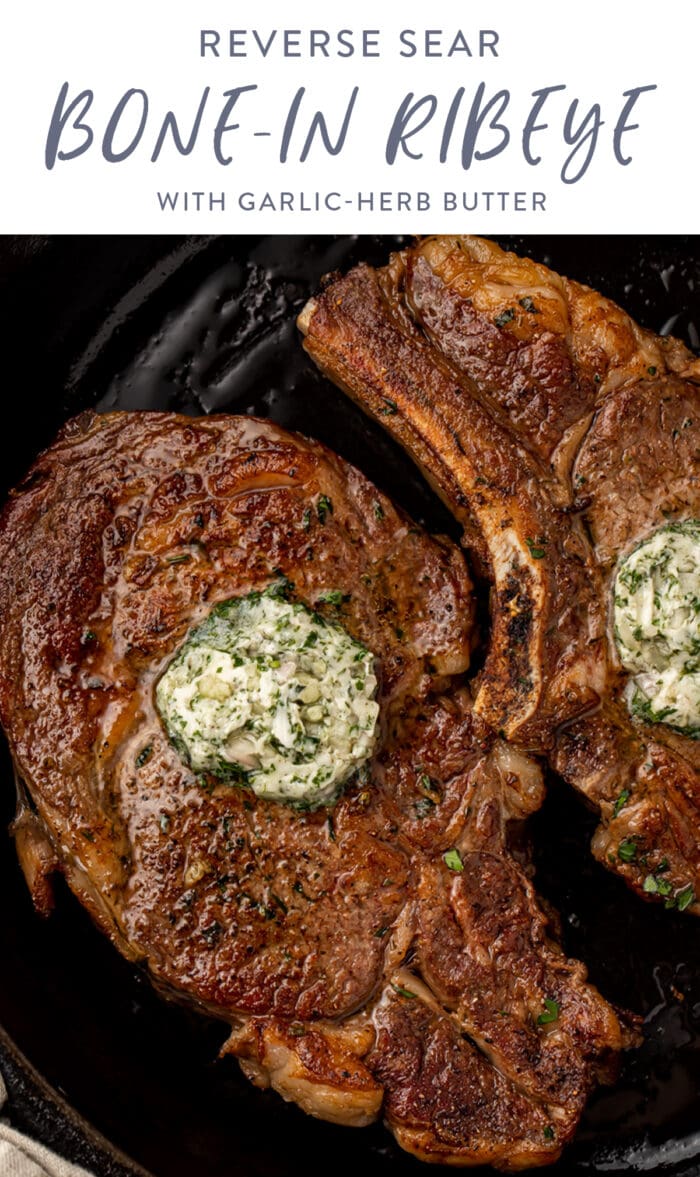
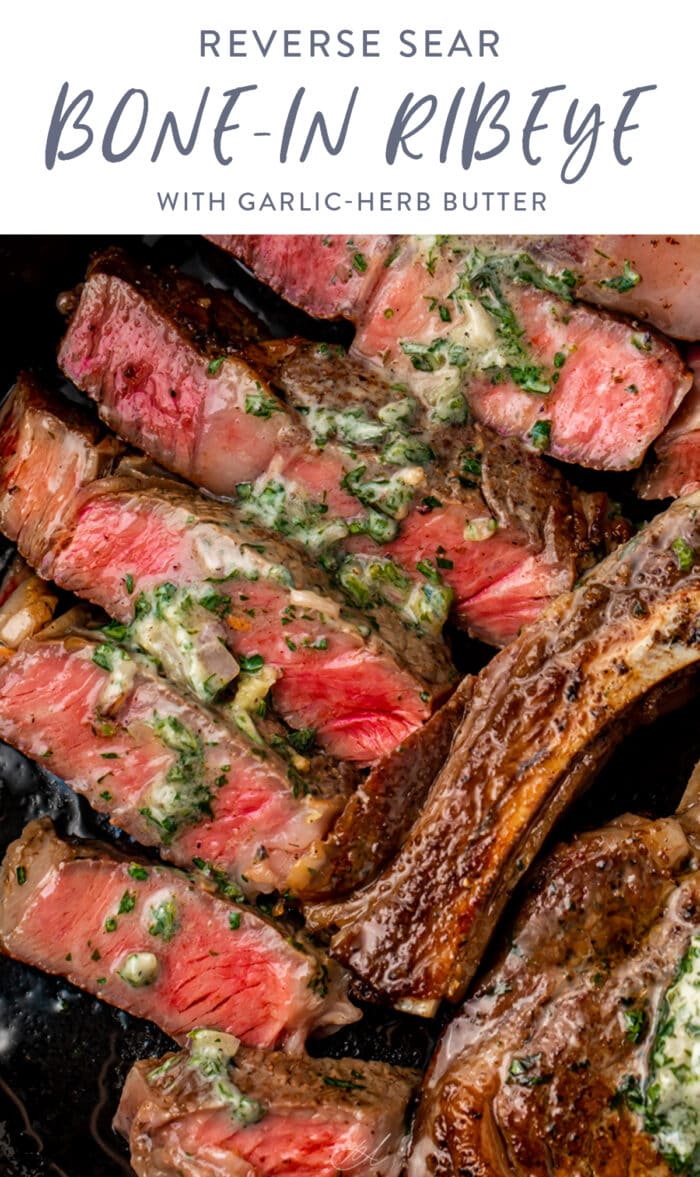

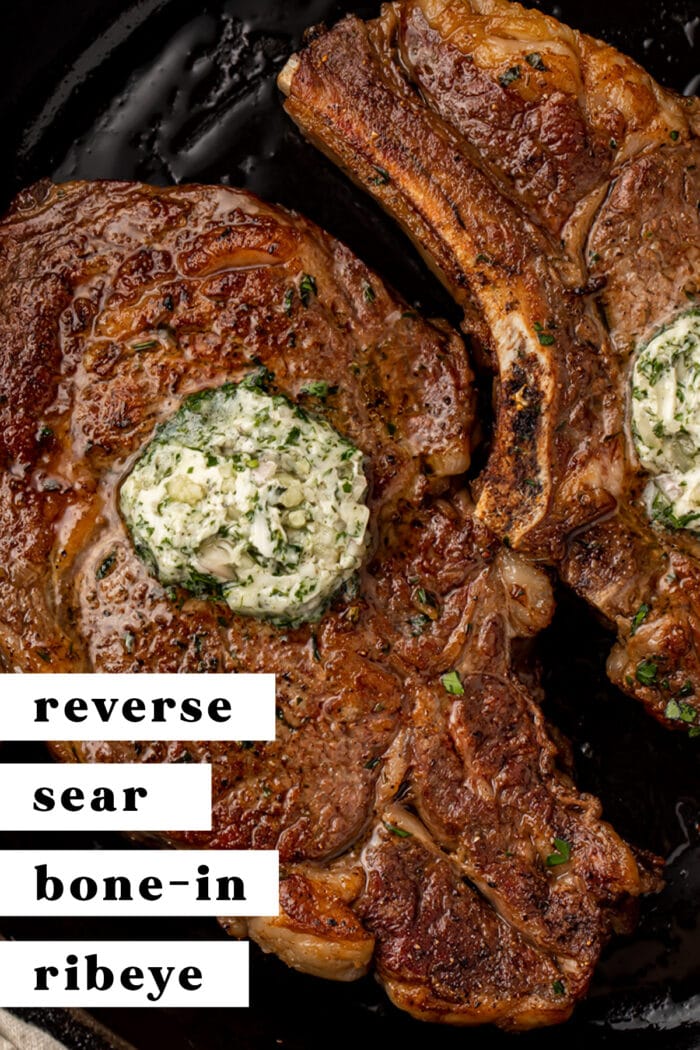
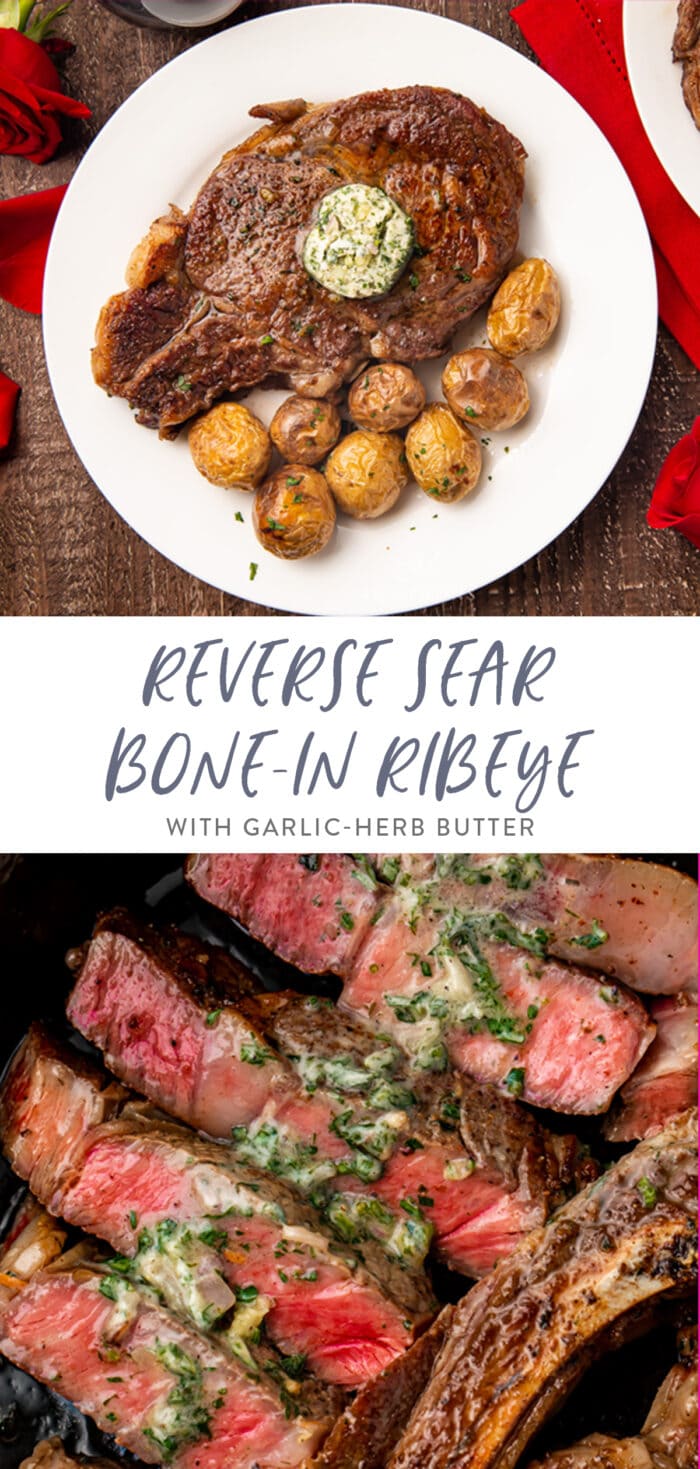
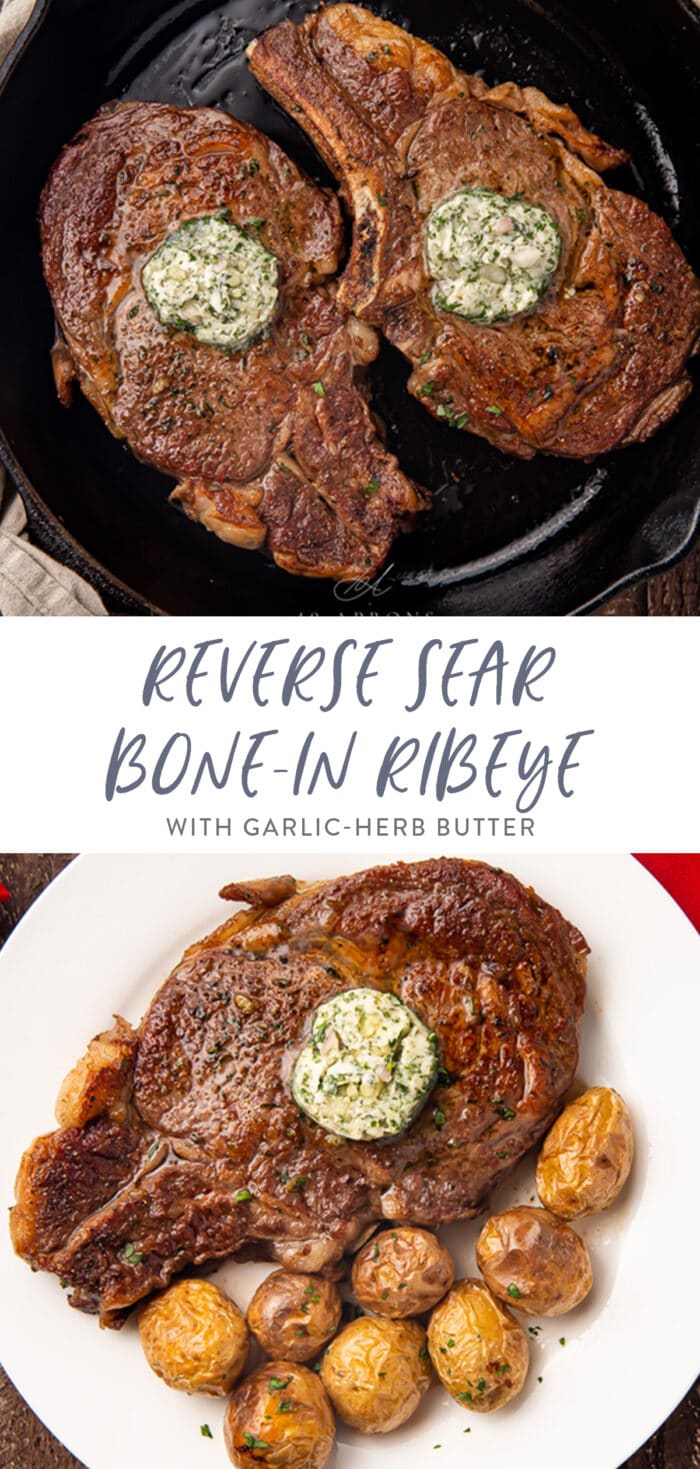
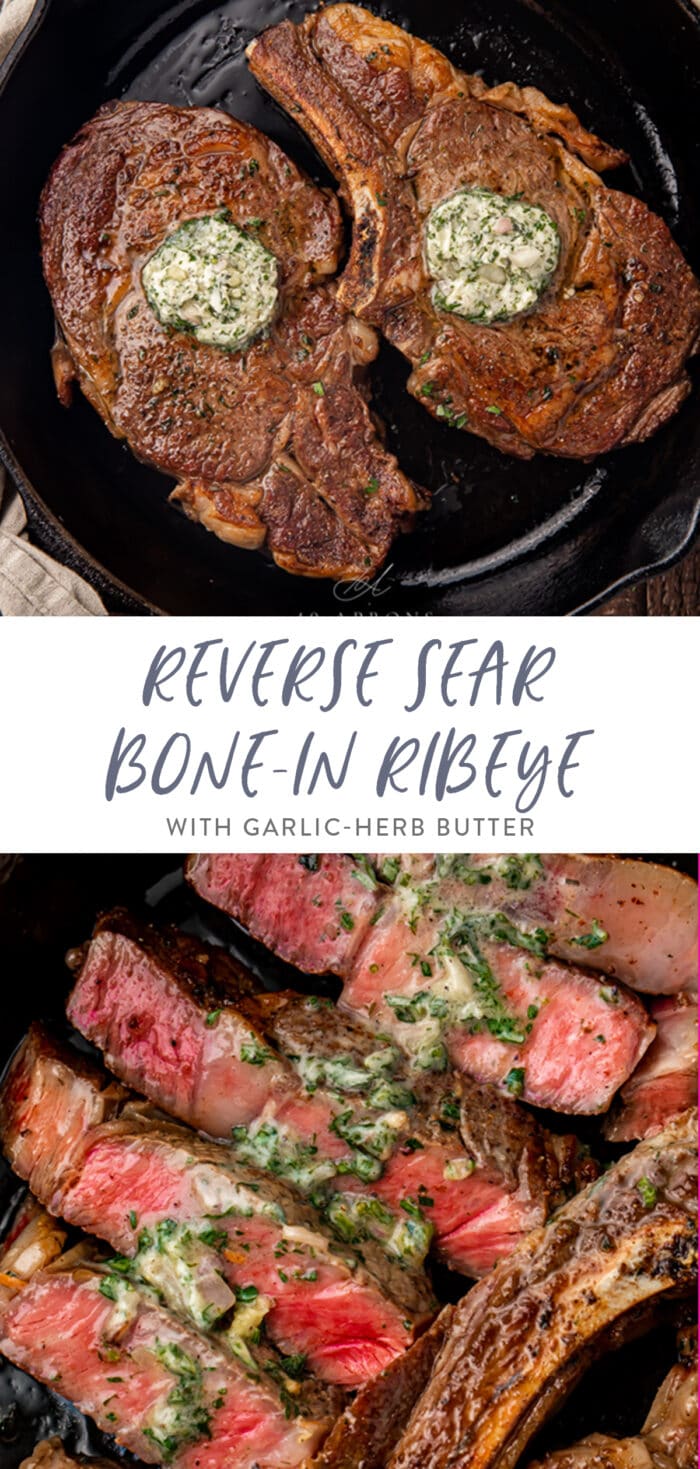

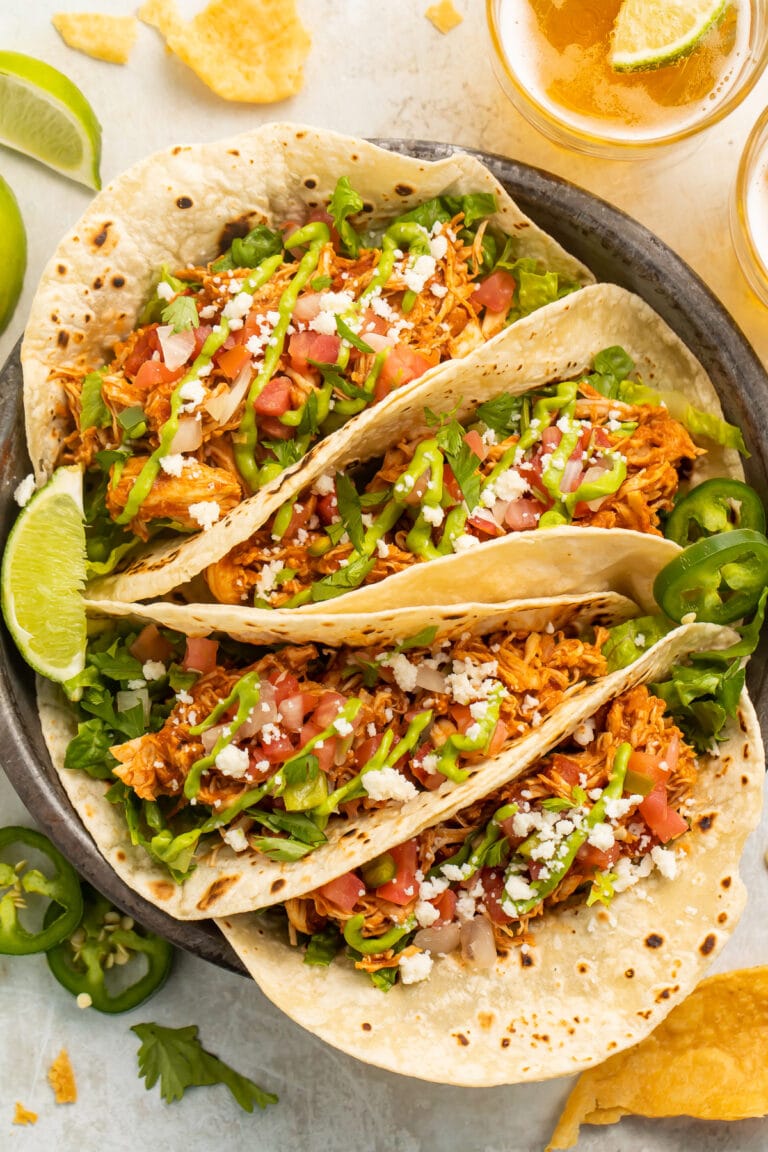


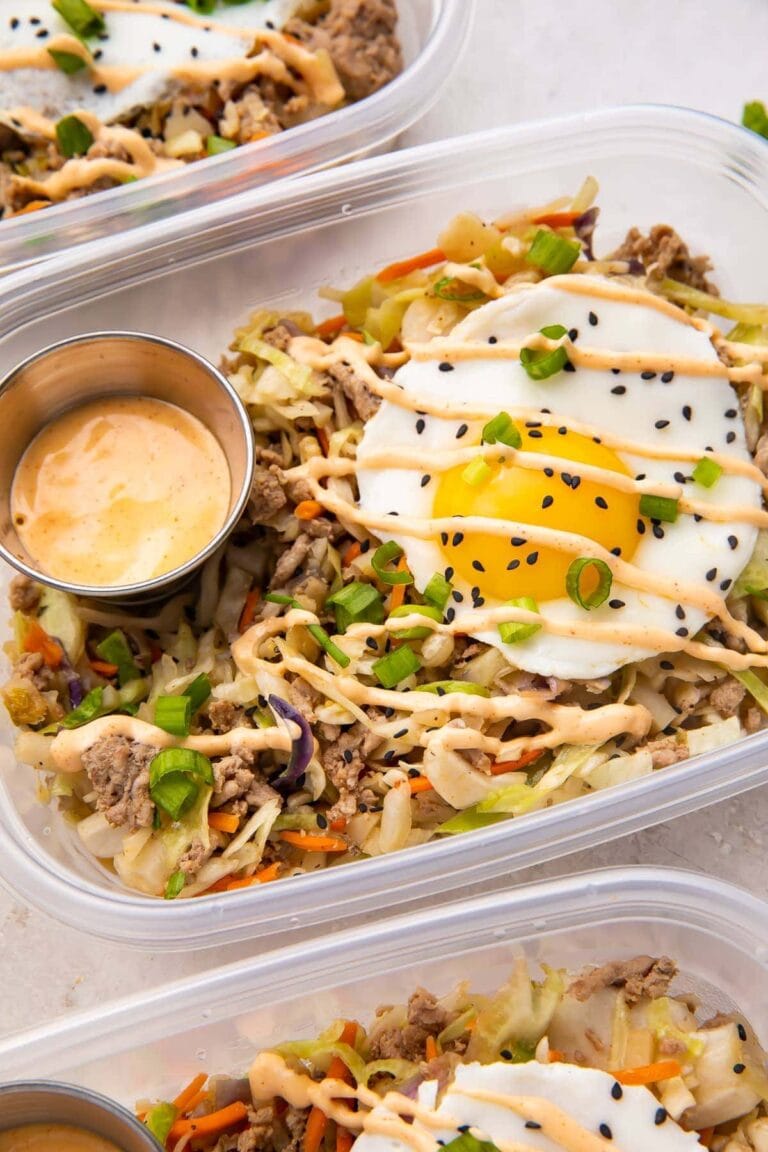
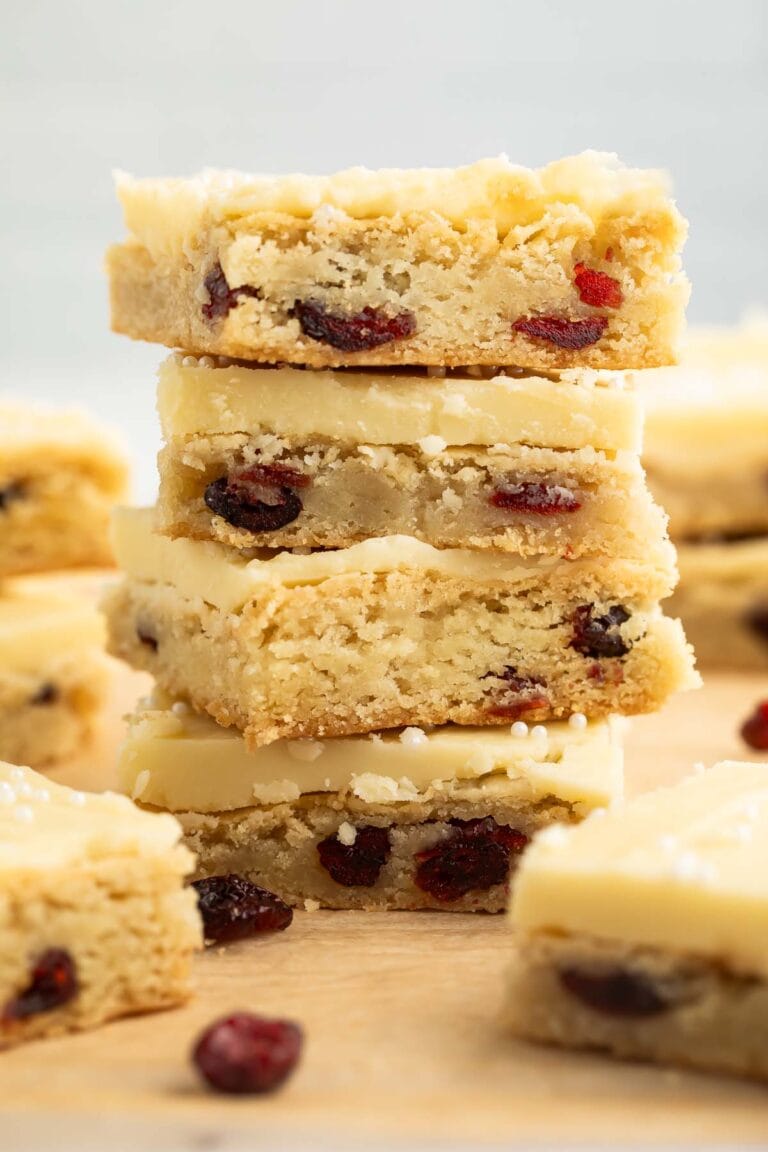










I’ll be honest. I was a bit leery of this method, but I love to learn new cooking techniques. We eat a lot of steak, but not usually bone-in ribeyes, so I decided to veer from my usual method (sear then oven).
I must say, this was pretty amazing. So incredibly tender. It ate like a filet. I will for sure add this to the rotation.
We’re so glad it was a hit! Thanks for sharing, Tiffany!
I struggle cooking steaks because everyone in our house likes them **shudder** well done. I took them out at about 150° and added some compound butter with garlic, herbs, Dijon and a dab of horseradish. Best steaks ever!
Haha, I’m so happy everyone enjoyed this version, Michele! Maybe you’ll convert them yet 😉
Amazing!
We agree! 🙂
Best steaks I’ve ever made!
So glad you enjoyed them! 🙂